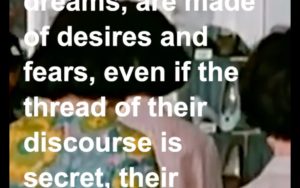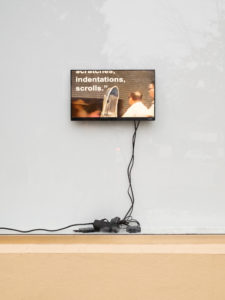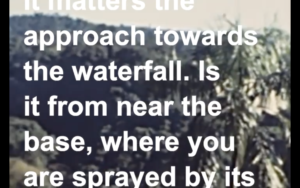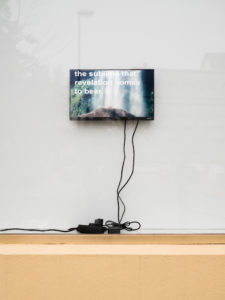12.23 Tiffany Sia Scroll Figure #3, Scroll Figure #4
More
Many of her latest film works delve into recent developments in the city of her birth: one of these, an experimental short titled Never Rest/Unrest, 2020, looks at the unrelenting political activity in Hong Kong between early summer and the end of 2019. Shot on a hand-held mobile device, it depicts what Sia has called “ambiguous, anachronistic and often banal time.” Do Not Circulate, 2021, a short essay video, follows a single media- and image trail around a specific event from that same year, also in Hong Kong. Its voiceover weaves leaks, rumor, and occult superstition into a single timeline. A third film, titled A Road Movie is Impossible in Hong Kong, 2021, shows the artist’s attempt at a week-long, episodic, live-stream landscape film that reimagines the road movie genre in Hong Kong.
Both Scroll Figure #3 and Scroll Figure #4 belong to part of a four-part series of videos. They analyze the tension between image and text intermittently and across eras and cultures. Each video tackles a specific topic such as time and warfare, the network-based dissemination of images through new media, the riddle of cities, or the enigma of the landscape. The same formal structure appears in each work in the series: videos play on a small-format screen with a 4:3 aspect ratio, though each screen is covered with a dark security foil that ensures that only one person—i.e., whoever is standing directly in front of the video—can watch it at a time. The effect is an intimate art-viewing experience not unlike reading a book. A text by the artist scrolls vertically over various archival film clips from the 1960s and ‘70s, much as it would roll across the screen of a teleprompter. The texts combine quotes from well-known writers and philosophers with fragments and commentary from the artist herself. Analogue film grain, mixed with pixilation on the accompanying background images lends them an almost painterly quality—they stand in stark contrast to the crisp, high-definition digital video more commonly seen today. The original footage could have been filmed on either Super 8 or 16mm film stock, as both analogue formats use the 4:3 aspect ratio.
Scroll Figure #3 references one of China’s best-known ancient artworks, a piece known as Along the River During the Qingming Festival. The handscroll painting measures 24.8 x 528.7 cm. Rendered by Song dynasty painter Zhang Zeduan (1085–1145), it shows various scenes of everyday life in the northern capital of the Song Dynasty (present-day Kaifeng) during Qingming, a Chinese festival commemorating the dead. Its central motif, apart from rural vignettes, is its depiction of a bustling cityscape complete with detailed premodern urban street scenes. The visual images in Scroll Figure #3 are a direct reference to the painting, except the city views here were captured on film in the 1960s and ‘70s. They show large numbers of city-dwellers engaged in ordinary activities, but also building facades and advertisements, passing cars on a multi-lane highway, and a river landscape. The compact 4:3 aspect ratio conveys a palpable sense of the city’s density and frenetic pace. Contrasting with these is the dense, scrolling text, an element that demands intense, sustained concentration on the part of the viewer. The video essay takes the celebrated scroll painting as a starting point for exploring the invisible souls of the deceased wandering through the city; for pondering the medial analogy between Chinese scroll paintings and the film reel; for contemplating a quote from the Italian writer Italo Calvino (1923–1985) and his 1972 novel Invisible Cities (Italian: Le città invisibili) and describing both high-rise facades that reflect the sky and the dominance of reflections, displays, and screens in the modern-day urban landscape. Fittingly, the artist also touches on the cinematic character of a Chinese scroll painting: “Embedded in the scroll is cinematic thinking: the slow tracking shot across a vast landscape showing various times on a linear plane, the shifting perspective and foreshortening of the image, the editing and focus on one section.”¹
Scroll Figure #4 finds the artist exploring both the motif of the waterfall in the landscape and the culturally-coded perception of the sublime as it relates to views of nature. Its featured footage shows waterfalls from different perspectives, though each shot only hints at the powerful spectacle of nature. Some clips allow us to make out sections of the surroundings, others confuse the eye with rushing, blurred volumes of water that ultimately flatten into abstract color fields. Three waterfalls are mentioned by name, but which are seen in the piece is left unknown: Iguazú Falls (Argentina/Brazil), the Xiao Wulai Waterfall (Taiwan), and Urami Falls (Japan). Some scenes show not only flora and fauna, but butterflies and buildings as well. Humans, by contrast, are kept out of sight.
The text in Scroll Figure #4 operates predominantly at a media-reflexive meta-level, primarily with regard to the analogy between waterfall and film. It begins with a discussion of the significance of the viewer’s perspective, followed by a quote from the French philosopher and media theorist Jean Baudrillard (1929–2007). The artist seizes on Baudrillard’s observations about the Iguazú Falls and his description of human intervention to reflect on the ways natural phenomena of this kind are presented in media. The video essay ends with commentary discussing the centuries-long, historically-conditioned process of perceiving landscape through the Western concept of the sublime in nature, with the artist noting, “There is a lot of meaning you can project onto such enigmas of landscape.” It becomes clear that what we mean by landscape today is only ever a culturally-conditioned extract—a construct no different than a painting, a film, and the processes of reception that go with them. Further highlighting the sublime in the field of poetry, Sia quotes a poem by the Japanese haiku master Matsuo Bashō (1644–1694), in particular his poetic experience of viewing the Urami Falls from a cave behind them: “Silent a while in a cave / I watched a waterfall, / For the first of / The summer observances.”
Tiffany Sia’s combining of text and image fragments from various different media contexts creates new intermedial and intercultural narratives, more specifically ones that challenge Western-centered modes of perception and visual interpretation of any kind. She interrogates the limits of visual media, expanding the Western-centric interpretive horizon with references from the East Asian cultural sphere.
Nevertheless, the connective link is ultimately the viewers themselves. The role of interpreter falls to them as well (mostly as individuals), since it is their culturally-informed perception that lends them both temporality and physical presence, especially in public space. The simultaneousness superimposition of text and image is sometimes deliberately meant to overwhelm the viewer with the act of reading and seeing, effectively forcing a kind of self-reflection. As the text and images reverberate like an echo, revising/re-visiting one’s own modes of perception and cultural appropriations seems all the more urgent—particularly in a global world coursing with visual media and narratives.
Tiffany Sia (b. 1988 in Hong Kong, lives and works in New York) studied at Bard College (US) and Qingdao University (CN). Recent solo exhibitions include those at the Vienna-based gallery FELIX GAUDLITZ (2022) and Artists Space, New York (2021). Her work has featured in a number of group exhibitions and screenings, including those at MoMA, New York, (to come in 2023); Seoul Museum of Art, Seoul (2022); Kunstverein für die Rheinlande und Westfalen, Düsseldorf (2022); Hordaland Kunstsenter, Bergen (2021); The Douglas Hyde Gallery, Dublin (2021); Blindspot Gallery, Hong Kong (2020). She has also screened films at a number of festivals, among others at the New York Film Festival, Toronto International Film Festival, MoMA Documentary Fortnight, Flaherty Film Seminar, and the Open City Documentary Film Festival. Films and video works by Sia Tiffany include What Rules The Invisible, 2022; Scroll Figure #1–#4, 2022; Do Not Circulate, 2021; A Wet Finger in the Air, 2021; A Road Movie is Impossible in Hong Kong, 2021; SEA – SHIPPING – SUN, 2021; and Never Rest/Unrest, 2020.
Both Scroll Figure #3 and Scroll Figure #4 belong to part of a four-part series of videos. They analyze the tension between image and text intermittently and across eras and cultures. Each video tackles a specific topic such as time and warfare, the network-based dissemination of images through new media, the riddle of cities, or the enigma of the landscape. The same formal structure appears in each work in the series: videos play on a small-format screen with a 4:3 aspect ratio, though each screen is covered with a dark security foil that ensures that only one person—i.e., whoever is standing directly in front of the video—can watch it at a time. The effect is an intimate art-viewing experience not unlike reading a book. A text by the artist scrolls vertically over various archival film clips from the 1960s and ‘70s, much as it would roll across the screen of a teleprompter. The texts combine quotes from well-known writers and philosophers with fragments and commentary from the artist herself. Analogue film grain, mixed with pixilation on the accompanying background images lends them an almost painterly quality—they stand in stark contrast to the crisp, high-definition digital video more commonly seen today. The original footage could have been filmed on either Super 8 or 16mm film stock, as both analogue formats use the 4:3 aspect ratio.
Scroll Figure #3 references one of China’s best-known ancient artworks, a piece known as Along the River During the Qingming Festival. The handscroll painting measures 24.8 x 528.7 cm. Rendered by Song dynasty painter Zhang Zeduan (1085–1145), it shows various scenes of everyday life in the northern capital of the Song Dynasty (present-day Kaifeng) during Qingming, a Chinese festival commemorating the dead. Its central motif, apart from rural vignettes, is its depiction of a bustling cityscape complete with detailed premodern urban street scenes. The visual images in Scroll Figure #3 are a direct reference to the painting, except the city views here were captured on film in the 1960s and ‘70s. They show large numbers of city-dwellers engaged in ordinary activities, but also building facades and advertisements, passing cars on a multi-lane highway, and a river landscape. The compact 4:3 aspect ratio conveys a palpable sense of the city’s density and frenetic pace. Contrasting with these is the dense, scrolling text, an element that demands intense, sustained concentration on the part of the viewer. The video essay takes the celebrated scroll painting as a starting point for exploring the invisible souls of the deceased wandering through the city; for pondering the medial analogy between Chinese scroll paintings and the film reel; for contemplating a quote from the Italian writer Italo Calvino (1923–1985) and his 1972 novel Invisible Cities (Italian: Le città invisibili) and describing both high-rise facades that reflect the sky and the dominance of reflections, displays, and screens in the modern-day urban landscape. Fittingly, the artist also touches on the cinematic character of a Chinese scroll painting: “Embedded in the scroll is cinematic thinking: the slow tracking shot across a vast landscape showing various times on a linear plane, the shifting perspective and foreshortening of the image, the editing and focus on one section.”¹
Scroll Figure #4 finds the artist exploring both the motif of the waterfall in the landscape and the culturally-coded perception of the sublime as it relates to views of nature. Its featured footage shows waterfalls from different perspectives, though each shot only hints at the powerful spectacle of nature. Some clips allow us to make out sections of the surroundings, others confuse the eye with rushing, blurred volumes of water that ultimately flatten into abstract color fields. Three waterfalls are mentioned by name, but which are seen in the piece is left unknown: Iguazú Falls (Argentina/Brazil), the Xiao Wulai Waterfall (Taiwan), and Urami Falls (Japan). Some scenes show not only flora and fauna, but butterflies and buildings as well. Humans, by contrast, are kept out of sight.
The text in Scroll Figure #4 operates predominantly at a media-reflexive meta-level, primarily with regard to the analogy between waterfall and film. It begins with a discussion of the significance of the viewer’s perspective, followed by a quote from the French philosopher and media theorist Jean Baudrillard (1929–2007). The artist seizes on Baudrillard’s observations about the Iguazú Falls and his description of human intervention to reflect on the ways natural phenomena of this kind are presented in media. The video essay ends with commentary discussing the centuries-long, historically-conditioned process of perceiving landscape through the Western concept of the sublime in nature, with the artist noting, “There is a lot of meaning you can project onto such enigmas of landscape.” It becomes clear that what we mean by landscape today is only ever a culturally-conditioned extract—a construct no different than a painting, a film, and the processes of reception that go with them. Further highlighting the sublime in the field of poetry, Sia quotes a poem by the Japanese haiku master Matsuo Bashō (1644–1694), in particular his poetic experience of viewing the Urami Falls from a cave behind them: “Silent a while in a cave / I watched a waterfall, / For the first of / The summer observances.”
Tiffany Sia’s combining of text and image fragments from various different media contexts creates new intermedial and intercultural narratives, more specifically ones that challenge Western-centered modes of perception and visual interpretation of any kind. She interrogates the limits of visual media, expanding the Western-centric interpretive horizon with references from the East Asian cultural sphere.
Nevertheless, the connective link is ultimately the viewers themselves. The role of interpreter falls to them as well (mostly as individuals), since it is their culturally-informed perception that lends them both temporality and physical presence, especially in public space. The simultaneousness superimposition of text and image is sometimes deliberately meant to overwhelm the viewer with the act of reading and seeing, effectively forcing a kind of self-reflection. As the text and images reverberate like an echo, revising/re-visiting one’s own modes of perception and cultural appropriations seems all the more urgent—particularly in a global world coursing with visual media and narratives.
Tiffany Sia (b. 1988 in Hong Kong, lives and works in New York) studied at Bard College (US) and Qingdao University (CN). Recent solo exhibitions include those at the Vienna-based gallery FELIX GAUDLITZ (2022) and Artists Space, New York (2021). Her work has featured in a number of group exhibitions and screenings, including those at MoMA, New York, (to come in 2023); Seoul Museum of Art, Seoul (2022); Kunstverein für die Rheinlande und Westfalen, Düsseldorf (2022); Hordaland Kunstsenter, Bergen (2021); The Douglas Hyde Gallery, Dublin (2021); Blindspot Gallery, Hong Kong (2020). She has also screened films at a number of festivals, among others at the New York Film Festival, Toronto International Film Festival, MoMA Documentary Fortnight, Flaherty Film Seminar, and the Open City Documentary Film Festival. Films and video works by Sia Tiffany include What Rules The Invisible, 2022; Scroll Figure #1–#4, 2022; Do Not Circulate, 2021; A Wet Finger in the Air, 2021; A Road Movie is Impossible in Hong Kong, 2021; SEA – SHIPPING – SUN, 2021; and Never Rest/Unrest, 2020.
Scroll Figure #3 / Scroll Figure #4, 2022
Video, color, no sound
03:51 min. / 03:01 min.
Courtesy of the artist and FELIX GAUDLITZ, Vienna
Text Cynthia Krell
Translation Amy Patton
¹ Breathing Cameras: Tiffany Sia, Tiffany Sia in conversation with Andrea Lissoni. By Andrea Lissoni and Tiffany Sia. Mousse Magazine, 21 April 2021, p. 144.
Close
Video, color, no sound
03:51 min. / 03:01 min.
Courtesy of the artist and FELIX GAUDLITZ, Vienna
Text Cynthia Krell
Translation Amy Patton
¹ Breathing Cameras: Tiffany Sia, Tiffany Sia in conversation with Andrea Lissoni. By Andrea Lissoni and Tiffany Sia. Mousse Magazine, 21 April 2021, p. 144.










